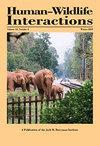作为作物保护手段的田间防护:对提高田间防护的初步启示
IF 0.9
4区 环境科学与生态学
Q4 BIODIVERSITY CONSERVATION
引用次数: 4
摘要
种植户与野生灵长类动物之间的负面互动是一个值得关注的问题。尽管许多农民使用田间守卫作为一种作物保护方法来对抗觅食的灵长类动物,但很少有关于这种技术的有效性和如何改进的公开报道。为了弥补这一知识差距,我们使用了从兽皮直接观察的方法来收集野战守卫的行为,chacma狒狒(Papio ursinus;狒狒)和长尾猴(Chlorocebus pygerythrus;2013年,在南非Blouberg区一个564公顷的商业农场,在一公顷的冬南瓜(Cucurbita moschata)地里觅食了4个月(5月至8月)。只有一半的农作物觅食事件被野地警卫追捕,长尾猴被追捕的频率远低于狒狒。警卫对灵长类动物数量较多的事件和当天早些时候发生的事件反应更频繁。在低生产力季节,狒狒对作物觅食事件的响应延迟和对守卫的响应延迟都增加了。狒狒的反应延迟也随着动物数量的增加而增加。在此基础上,提出了提高野战防护效能的建议。这包括实施预警报警系统,缩短野战警卫班次,在上午和低生产力季节增加警卫人数,并增加对野战警卫的恐惧,可能通过雇用男性警卫或提供制服和威慑配件。在其他地方情况下的进一步评价将有助于确定如何在更大范围内采用这些发现。本文章由计算机程序翻译,如有差异,请以英文原文为准。
Field Guarding as a Crop Protection Method: Preliminary Implications for Improving Field Guarding
Negative interactions between crop farmers and wild primates are an issue of significant concern. Despite many crop farmers using field guards as a method of crop protection against foraging primates, there are very few published accounts of how effective this technique is and how it might be improved. To bridge this knowledge gap, we used direct observations from a hide to collect the behaviors of field guards, chacma baboons (Papio ursinus; baboons), and vervet monkeys (Chlorocebus pygerythrus; vervets) foraging in a 1-ha butternut squash (Cucurbita moschata) field for 4 months (May to August) in 2013 on a 564-ha commercial farm in the Blouberg District of South Africa. Only half of the cropforaging events were chased by field guards, with vervets being chased much less frequently than baboons. Guards responded more often to events with greater primate numbers and to those that occurred earlier in the day. Guard delay in responding to crop-foraging events and baboon delay in responding to the guard both increased in the low productivity season. Baboon response delay also increased with more animals involved. Based on this case study, we suggest recommendations to improve the effectiveness of field guarding. This includes implementing an early warning alarm system, shortening field guard shifts, increasing guard numbers during the morning and low productivity season, and increasing the perceived fear of field guards, potentially by employing male guards or providing uniforms and deterrent accessories. Further evaluation in other local contexts will help determine how these findings can be adopted on a wider scale.
求助全文
通过发布文献求助,成功后即可免费获取论文全文。
去求助
来源期刊

Human–Wildlife Interactions
Environmental Science-Nature and Landscape Conservation
CiteScore
2.80
自引率
0.00%
发文量
0
审稿时长
11 weeks
期刊介绍:
Human–Wildlife Interactions (HWI) serves the professional needs of the wildlife biologist and manager in the arena of human–wildlife conflicts/interactions, wildlife damage management, and contemporary wildlife management. The intent of HWI is to publish original contributions on all aspects of contemporary wildlife management and human–wildlife interactions with an emphasis on scientific research and management case studies that identify and report innovative conservation strategies, technologies, tools, and partnerships that can enhance human–wildlife interactions by mitigating human–wildlife conflicts through direct and indirect management of wildlife and increased stakeholder engagement. Our intent is to promote a dialogue among wildlife professionals concerning contemporary management issues. As such, we hope to provide a repository for wildlife management science and case studies that document and share manager experiences and lessons learned.
 求助内容:
求助内容: 应助结果提醒方式:
应助结果提醒方式:


